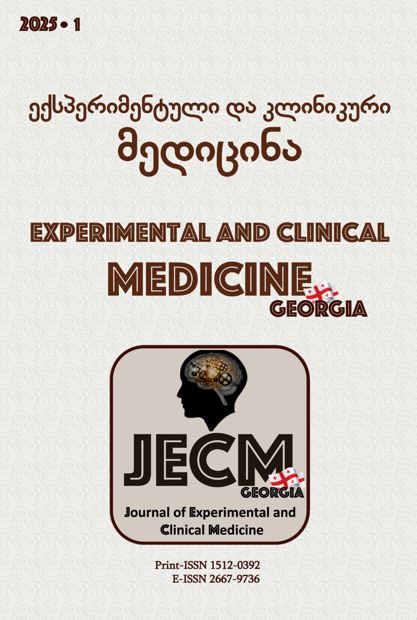PROBING ELECTRON TRANSFER AND THERMAL STABILITY OF GLYCATED BY LACTOSE CYTOCHROME C
DOI:
https://doi.org/10.52340/jecm.2025.01.20Keywords:
Cytochrome C, Glycation, Lactoze, cyclic voltammetry, calorimetry, electron transferAbstract
The electron exchange process and thermal stability of the lactose-glycated Cytochrome C (Cyt C) during the 14-day glycation period (T = 25 0C) were observed. The oxidation and reduction reaction rate of Cyt C at a modifier-coated gold electrode, as well as the thermodynamic stability of protein at different stages of the glycation process, were measured using, respectively, cyclic voltammetry and microcalorimetric methods. The obtained experimental results indicate that glycation with lactose leads to a sharp deterioration of the redox activity of Cyt C one week after the beginning of the glycation period. At the same time, the global thermal stability of the protein is maintained for at least two weeks of the glycation period.
Downloads
References
Dolidze T., Makharadze M., Uchaneishvili S., Khoshtariya D. Impact of prolonged glycation pre-treatment on the electron transfer kinetics of cytochrome C. Experimental and Clinical Medicine Georgia. 2024, (2), 11–13. https://doi.org/10.52340/jecm.2024.02.02 .
Schachinger F., Scheiblbrandner S., Karnpakdee K., et al. Cytochromes as electron shuttles from FAD-dependent glucose dehydrogenase to electrodes Electrochimica Acta. 2023, 458 142485.
Scott R. A., Mauk A. G. Cytochrome C. A. Multidisciplinary Approach; University Science Books: Sausalito. 1996.
Guerra-Castellano A., Márquez I., Pérez-Mejías G., Díaz-Quintana A., De la Rosa M.A. and Díaz-Moreno I. Post-Translational Modifications of Cytochrome c in Cell Life and Disease. Int. J. Mol. Sci. 2020, 21, 8483; doi:10.3390/ijms21228483.
Fedurco M. Redox reactions of heme-containing metalloproteins: dynamic effects of self-assembled monolayers on thermodynamics and kinetics of cytochrome c electron-transfer reactions. Coordination Chemistry Reviews. 2000, 209(1), 263–331. doi:10.1016/s0010-8545(00)00292.
Sharma G. S., Warepam M., Bhattacharya R., & Singh L. R. Covalent Modification by Glyoxals Converts Cytochrome c Into its Apoptotically Competent State. Scientific Reports. 2019, 9(1). doi:10.1038/s41598-019-41282-2.
Cussimanio B.L., Booth A.A., Todd P., Hudson B.G., Khalifah R.G. Unusual susceptibility of heme proteins to damage by glucose during non-enzymatic glycation Biophysical Chemistry 2003, 105, 743–755.
Hildick-Smith G.J., Downey M.C., Gretebeck L.M., Gersten R.A., Sandwick R.K. Ribose 5-Phosphate Glycation Reduces Cytochrome C Respiratory Activity and Membrane Affinity. Biochemistry. 2011, 50, 11047–11057.
Delgado Y., Morales-Cruz M., Hernández-Román J., Martínez Y. and Griebenow K. Chemical glycosylation of cytochrome c improves physical and chemical protein stability. Delgado et al. BMC Biochemistry. 2014, 15:16 http://www.biomedcentral.com/1471-2091/15/16.
Sol R. J., Rodriguez-Martinez J. A. and Griebenow K. Modulating protein biophysical properties by chemical glycosylation: biochemical insights and biomedical implications. Cell. Mol. Life Sci. 64. 2007, 2133 – 2152. DOI 10.1007/s00018-007-6551-y.
Khoshtariya D.E., Dolidze T.D., Seyfert S., Sarauli D., et al. Kinetic, thermodynamic and mechanistic patterns for free (unbound) Cytochrome C at Au/SAM junction. Impact of electronic coupling, hydrostatic pressure, and stabilizing/denaturing additives. Chem. Eur. J. 2006, 12 (27), 7041-7056.
Dolidze T.D., Khoshtariya D.E., Waldeck D.H., Macyk J. & van Eldik R. Positive activation volume for a cytochrome c electrode process: Evidence for a "protein friction" mechanism from the high-pressure studies. J. Phys. Chem. B. 2003, 107, 7172-7179.
Nicholson R.S., Theory and Application of Cyclic Voltammetry for Measurement of Electrode Reaction Kinetics, Anal.Chem. 1965, 37,1351-1355.
Machado J.B., Coutinho J.A., Macedo E.A. Solid-liquid equilibrium of a-lactose in ethanol/water. Fluid Phase Equilibria 173. 2000, 121–134.






